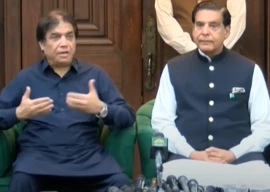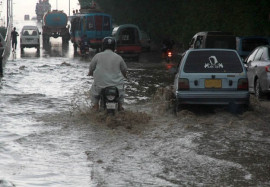
And yet if we look at the year gone by closely enough, it is replete with tragedies involving children. Can we gloss over the large number of child fatalities from various health-related challenges including 1,130 in Thar, 75 in District Headquarters Hospital in Sargodha and 149 from measles compared to 339 in 2013?
At least 295 children were reportedly crippled by polio in 2014.
The shocking figures of children we lost in the year from preventable causes and who suffered lifelong disability raises questions over the government’s initiatives to secure its future generation.
In South Asia Pakistan has the second highest infant and child mortality rate and is currently lagging far behind in achieving Millennium Development Goals (MDGs) 2015.
Malnutrition mortality in Thar
Almost every single day of 2014 at least two infant deaths were reported from Tharparkar due to the current drought. But the issue was not taken seriously.
According to the recent nutrition survey conducted in Tharparkar in collaboration with international agencies, it was revealed that an estimated 29% children were malnourished out of which 6.2% suffered acute malnutrition and 22.7% were moderate acute malnutrition, which is above the WHO threshold for emergency, that is 15%.
Pertab Shivani, executive director of Search, a local organisation working for the relief of famine-hit population in Tharparkar, said the on-going tussle between the two prominent political parties is one of the reasons behind the current situation.
Deaths in DHQ Sargodha
Talking to The Express Tribune Dr Pervez Haider, medical superintendent at DHQ hospital Sargodha, said that the children did not die due to absence of medical facilities at the hospital but because of malnutrition as their mothers were malnourished who gave birth to the premature babies.
Preventable diseases under EPI
However, routine immunisation was put on the back burner as the government focus remained on the polio eradication but as compared to 2013 a decline has been witnessed in the number of cases of nine vaccine preventable diseases under Expanded Programme on Immunisation (EPI) in 2014.
According to the data compiled by the EPI a total of 11,754 cases of measles were reported in 2014 compared to 43,973 reported in 2013, Diphtheria cases declined from 183 to 76, Pertussis cases decreased from 235 to 193, Neo Natal Tetanus (NNT) cases from 898 to 636 and tuberculosis from 174 t0 103.
Lowest breastfeeding rates
The federal government had notified the Infant Feeding Board in October 2013 to implement breastfeeding law but due to lack of interest failed to hold even a single meeting in 2014.
Despite of the fact that Pakistan has the highest bottle-feeding rates and lowest exclusive breastfeeding rates in South Asia which is worrisome.
Polio cases
Despite the fact that the government remained very much focused on eradicating polio from the country in 2014 while ignoring other health issues, the year turned out to be the darkest one in terms of the explosive polio outbreak that left at least 295 crippled for life compared to 77 in 2013. Once again Pakistan reported the highest number of polio cases anywhere in the world in the previous year.
The numbers of infected districts was also raised to 36 compared to 21 in 2013 meanwhile environmental surveillance testing of sewage water since January 2014 gave clear evidence that the virus is still circulating across the country.
Published in The Express Tribune, January 3rd, 2015.

1729156706-0/Untitled-design-(33)1729156706-0-270x192.webp)
















COMMENTS
Comments are moderated and generally will be posted if they are on-topic and not abusive.
For more information, please see our Comments FAQ